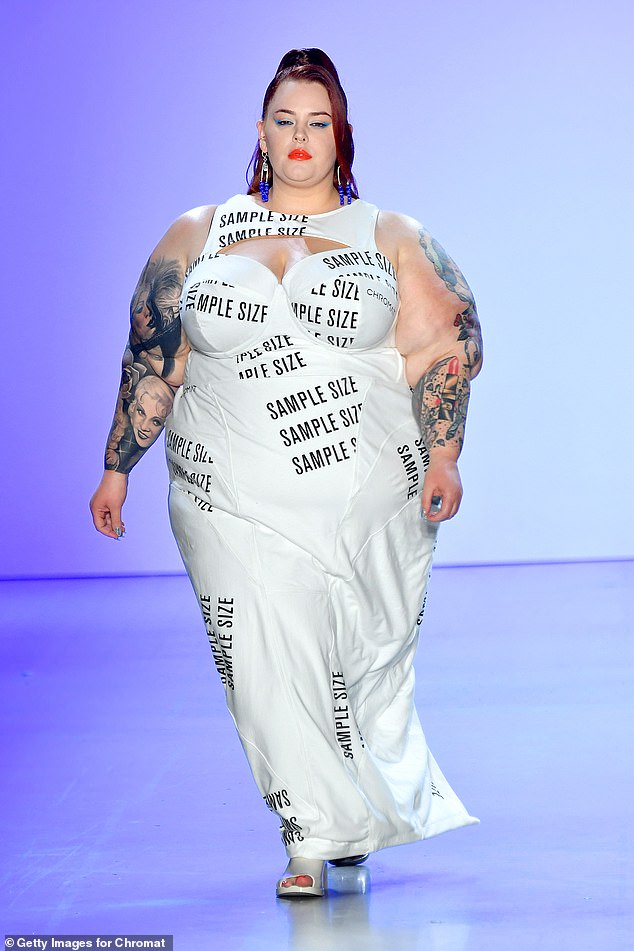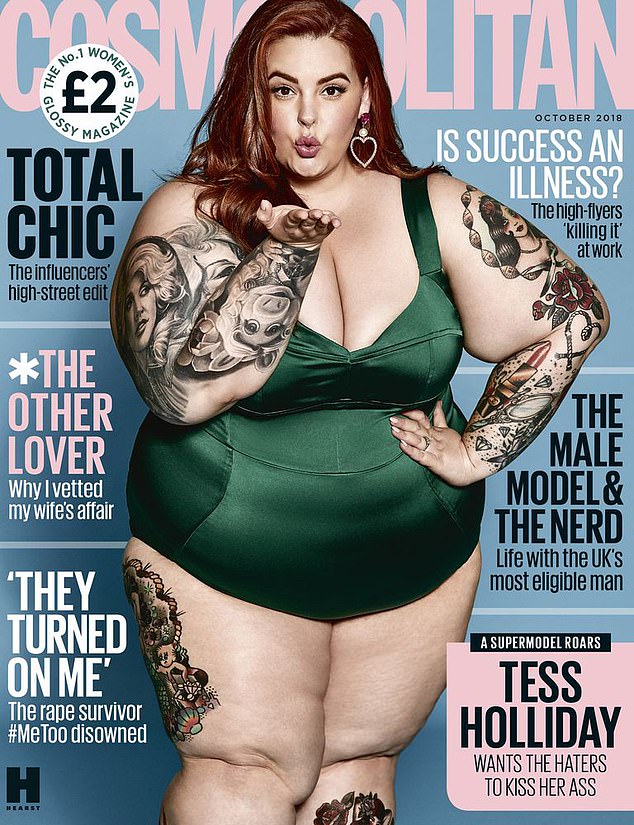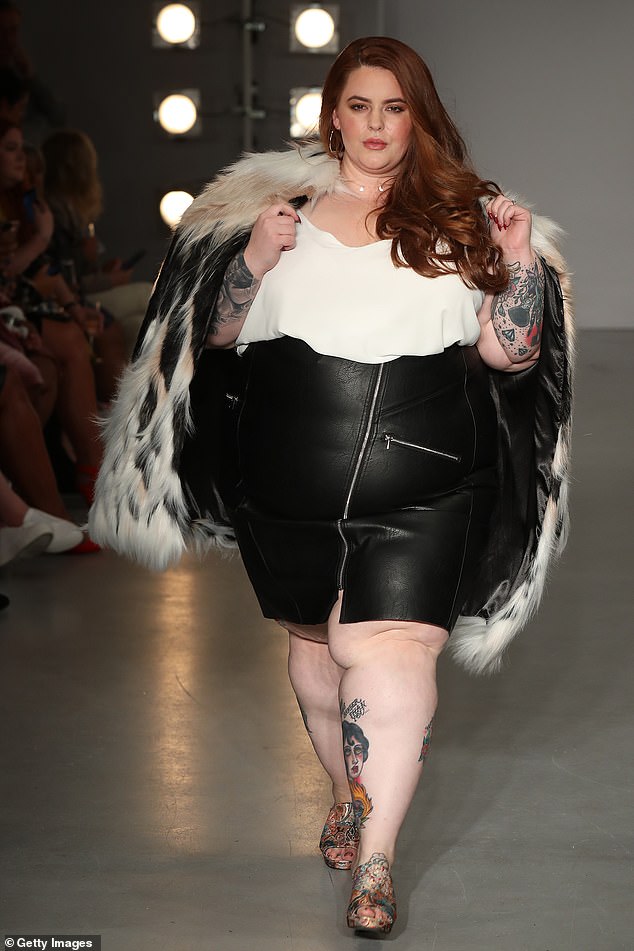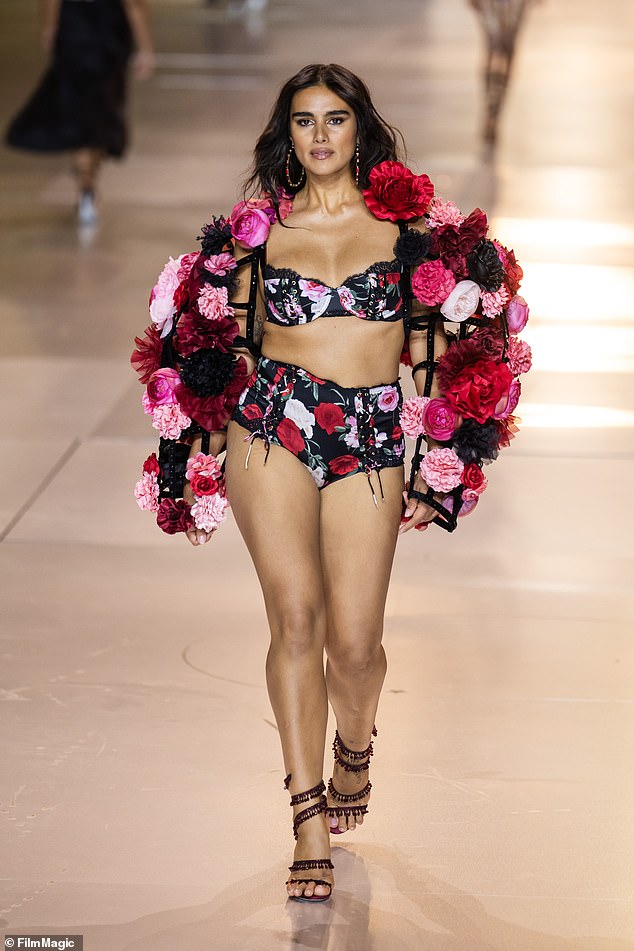It’s hard to believe just six years ago we were in the middle of a ‘body positivity’ movement.
Catwalks featured models with tummies and thighs and dimples in places that real women have them. Clothing brands such as Reformation and Madewell proudly (and loudly) announced the expansion of their size ranges. Billboards featured models with hips and boobs and folds and rolls.
Even out on the street you could see young women flaunting tummies in crop tops and bottoms in teeny, tiny cycling shorts. Everybody was beautiful, was the message. Wear it how you see fit.
Today it’s a very different story. The major catwalks are almost entirely devoid of larger models. A recent report by Vogue Business revealed that just 0.3 per cent of the Autumn/Winter 2025 catwalk looks shown during the most recent fashion weeks in New York, London, Milan, and Paris were on plus-size models (a UK size 18 or over).
In Milan, not a single model was plus-size and in London representation halved. A huge 97.7 per cent of the models on show were a tiny size 4-8, while just 2 per cent were so-called ‘mid-size’ (UK sizes 10-16). One fashion casting agent told Vogue Business that models were turning up to castings looking clearly ‘unwell’, so thin, they were ‘shivering … their lips blue’.
Meanwhile, many fashion brands have quietly retracted or reduced their plus-size ranges, or – like River Island – taken them out of High Street stores altogether.
But perhaps the most shocking sign of the body positive movement’s demise came earlier this year with the release of TikTok’s AI-generated so-called ‘Chubby Filter’, which made uploaded selfies ‘fat’, with bigger thighs, waists, hips and faces. Briefly, the trend exploded, and not in a kind or body positive way, but with users posting for a laugh and openly expressing disgust at their ‘fat versions’.

Tess Holliday on the catwalk for Chromat in 2020 during New York Fashion Week
Eventually, TikTok reacted to criticism and pulled the filter, but not before it’d revealed a troubling rise in mockery, even hatred, of the plus-size look online. You couldn’t imagine such a filter being launched just a few years ago.
Perhaps it’s partly to do with the craze for weight-loss injections like Ozempic and Mounjaro, which has swept its way over bodies big and small over the last two years, but the vogue for ‘thin’ – coupled with a hatred for ‘fat’ – feels as feverish now as it was back in the 1990s ‘heroin chic’ days.
So what happened? Was embracing ‘real bodies’ just a blip? A moment that fell fashionably in line with the surge in DEI – diversity, equity and inclusion – culture?
Or worse, was the body positivity movement nothing more than the result of a social media pile-on, forcing the wider world to embrace a culture they never had any intention of embracing?
I was a teenager in the 1990s, reading magazines that flaunted skeletal bodies as high fashion. It did untold damage to the 14-year-old, magazine-mad me, who consequently worshipped women like Kate Moss, Jodie Kidd and every other model who had legs like linguine and ‘cool’ concave faces.
I suffered from an eating disorder for most of my teens, while disordered eating and body loathing has plagued my entire life. (Were magazines the only reason? No they were not, but they were a major part of a culture that fetishised thin and equated it with beauty.)
When I finally became an editor of my own fashion magazine I wanted to help change the conversation around beauty standards.
Luckily for me that magazine was Cosmopolitan, a brand that was unusually progressive when it came to size inclusivity.

Former Cosmopolitan editor Farrah Storr cast plus size model Tess Holliday as a cover star
Almost every editor that came before me had encouraged fashion shoots with larger models and chosen cover stars like Kelly Osbourne and Khloé Kardashian (now both shockingly slimmer – both have denied using Ozempic), who didn’t necessarily fit the archetypal fashion magazine mould. It felt like a magazine that could strike out and make a stand.
Still, I knew it would not be easy.
Fashion editors told me stories of requesting bigger sized models from agencies only to be sent girls with 33-inch hips (roughly a size 6) and a C-cup cleavage.
Then there were issues with clothes – few truly fashionable brands made anything over a size 14. As for luxury brands? Forget it. The clothes they sent for fashion shoots were all sample size – in other words a size 8 or, often, much smaller.
And so that was how it went. You requested, often under duress, the models you knew could fit into the clothes you wanted to offer to your readers. Simple as.
And yes, you felt bad about it. Though not quite bad enough to do anything monumental about it.
Around 2018, however, I read the autobiography of a young model called Tess Holliday. The book moved me, charting her rise from a poor young woman growing up in America’s deep south with zero connections in the fashion industry to being signed to one of the biggest modelling agencies in the world despite the fact she was 5ft 2 and weighed 17 and a half stone.
Here was a gutsy, go-getting young woman who refused to let the world define her. She was, to me at least, the perfect Cosmo cover girl.

Tess Holliday on the SimplyBe ‘Curve Catwalk’ during London Fashion Week in 2017
Of course, up until that point there had never been anyone like Tess on a glossy magazine cover before. Occasionally someone had ‘braved’ putting a bigger model on the cover of a fashion magazine – a size-12 Sophie Dahl on the cover of Vogue, for example. Or Candice Huffine’s size-16 frame on American Elle’s cover.
But given the average British woman is a size 16, it never struck me as brave at all. That was just art imitating life.
Tess however was different. She was bigger than other models. She was shorter too. What’s more she had amassed a community of millions with her Eff Your Beauty Standards social media ‘movement’ encouraging women to be unapologetic about their bodies, whatever their size.
She arrived at the photo studio nervous and giddy as we showed her the small rail of clothes we had managed to cobble together. None of the usual fashion houses or designers could help, since no one made clothes in Tess’s size, which was a UK size 24.
This was 2018, however, and the body positivity movement was about to hit its peak. Brands in the US such as Old Navy, Nasty Gal and J Crew had all expanded their size range. A size-16 supermodel called Ashley Graham had just stormed the catwalk at New York fashion week, while Nike was gearing up to fill its London flagship store with its plus-size (and para sport) mannequins for the first time in fashion history.
We shot various pictures of Tess that day – one in a tulle dress, another in a black body-con dress and, finally, Tess in an emerald-green body suit that came with its own tailor to help get the fit right. And that was the outfit that felt right – both honest and celebratory, showing the reality of a truly plus-size body.
This wasn’t our way of saying every woman should look like Tess necessarily. And I stand very firm on that.
It was just that after decades of smaller models gracing magazine covers we wanted, in our own small way, to try to redress the balance.

Jill Kortleve, a Dutch supermodel who is often cited as ‘plus-size’ is, in fact, a size 12-14
What I should also say here – and I think it’s an important point, is that the Tess Holliday cover was never about glamorising obesity – an argument I have always believed dressed up fat phobia as societal concern. It was far more nuanced than that. It was about opening up a dialogue about who gets to be beautiful and who doesn’t.
Of course, when the magazine cover hit news stands in September that year, the world went mad. People called for my resignation – many of them our own readers. I went on breakfast television and was hauled in front of Piers Morgan, who said it encouraged obesity.
I was even sent a death threat on a hand-written note for putting ‘a whale’ on the cover. People – most of them women, it has to be said – were not comfortable with a body that deviated so widely from what we had been told was acceptable.
Thankfully, for every complaint, there were a hundred different female voices saying thank you.
Not because they wanted to look like Tess. They just wanted some form of cultural acknowledgement that there was a world out there made up of wildly different body shapes and sizes. And they wanted the world to take note.
For some years after that, the body positivity movement did just that.
Most major fashion brands expanded their size range – American Eagle, Adidas, Lululemon. Old Navy ran an audacious marketing campaign called Bodequality that promised price parity for all sizes. (They had previously been accused of charging up to £11 more for plus-size jeans).
Pretty Little Thing posted an image of a size-20 model in one of their bikinis. Supermodels with hips and thighs such as Paloma Elsesser and Precious Lee joined Ashley Graham on the catwalk. (Lee also went on to become the face of Versace, one of the first ‘curve’ models to do so).
Lizzo appeared on the cover of Vogue. Even Hollywood seemed, finally, to be filled with bodies that looked a lot like ours – Mindy Kaling, Kelly Clarkson, Amy Schumer.
Victoria’s Secret finally featured a plus-size model (Ashley Graham) at its famous runway show last year, after previously having announced they felt the public ‘had no interest in it’.
It seemed like everybody had woken up to the fact that real women came in all different shapes and sizes.
But then something shifted. It’s hard to pin-point when exactly – culture doesn’t just upend over-night.
First the catwalks went smaller. The plus-size models became size-14 models, then size 12, then size 10. (Jill Kortleve a Dutch supermodel who is often cited as ‘plus-size’ is, in fact, a size 12-14.) These women are referred to as mid-size girls – they have curves and hips and are all phenomenally beautiful and I’m very glad they exist, but they are hardly a flag for real plus-size women.
In 2020, according to The Fashion Spot, 46 plus-size models walked the catwalks; in spring 2023 that number had fallen to just 17.
Next came the excuses from brands who had once upon a time been so vocal about their support. Old Navy blamed its falling sales on the failure of its plus-size inclusivity project and was cutting back on its plus-size inventory as a result.
Others were subtler – slowly, imperceptibly phasing out many of their plus-size styles.
Across social media, women once again complained of the lack of plus-size choices within brands where they had once shopped freely just years before.
To prove the point, recent research by Impact Analytics, which documents retailers’ inventory, said that sales of size L, XL and XXL have decreased by nearly 11 per cent. Fashion brand Reformation’s extended sizing range has decreased by 46 per cent year on year.
I decided to get back in touch with Tess Holliday, my original Cosmo cover girl, to see what she thought.
‘Over the past five years, there’s been a dramatic shift in the fashion and modelling industry when it comes to size inclusion,’ Tess told me from her home in LA. Now 39, she still works as a body image activist and has written a book for young people called Take Up Space Y’All.
‘Bookings for plus-size talent are significantly slower than they were even just a few years ago. I’ve seen firsthand how brands that once proudly launched plus-size ranges or hired diverse bodies are quietly (and not so quietly) pulling back.
‘Some of those same brands don’t even return calls now. It feels like we’re being erased all over again.’
As for the celebrities who claimed to be proud of having bigger bodies in a world of ‘thin’, you only need to look at the evidence.
US actress Mindy Kaling and singer-songwriter Kelly Clarkson are both half the size they once were a few years back, while actress Amy Schumer, who is also noticeably slimmer, now admits to taking Mounjaro.
As for the rest of us? Look around your social circle and you’ll see for yourself. Is everyone only eating half their meal? Have they stopped talking about diets yet look noticeably leaner? Chances are they, like so many right now, have turned to the ‘jab economy’ – weight-loss injections like Ozempic, Mounjaro and Wegovy.
What now for a body positive movement which appears to be rapidly fading from the conversation?
As Donald Trump doubles down on purging the diversity, equity and inclusion agenda from corporate life, this may be the very excuse marketeers have been looking for to exit from a cause that was never anything more than a passing fashion fad for them.
With US trade tariffs looking especially punitive to western fashion brands who rely on Asian manufacturing, we may also see the return of the well-worn excuse that plus-size clothing is simply too expensive to make work.
But here’s an even darker thought – maybe, ultimately, we are to blame for the demise of body positivity?
Because as millions of perfectly average-sized women (and men) throw their bodies at the feet of weight-loss pharmaceutical companies, you have to ask yourself: did we as a culture ever really buy into the idea that every body is beautiful? Or was it just one big, fat lie?
For my part, I hope not.







